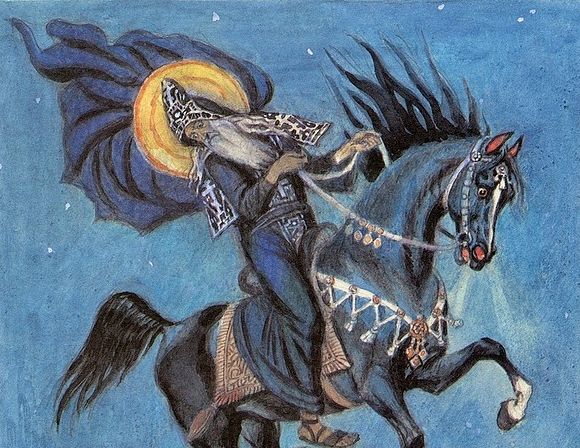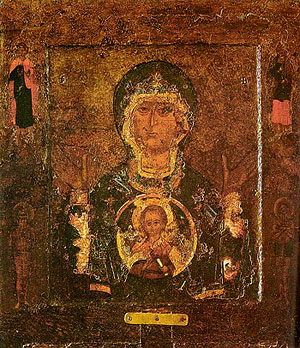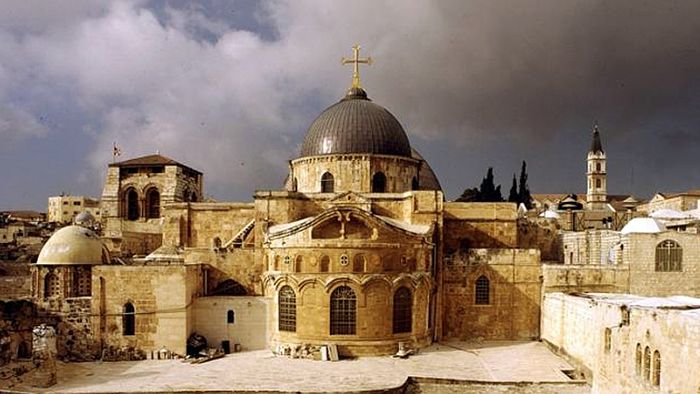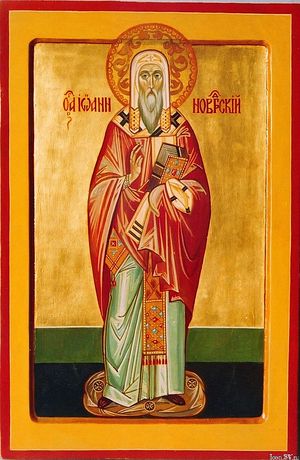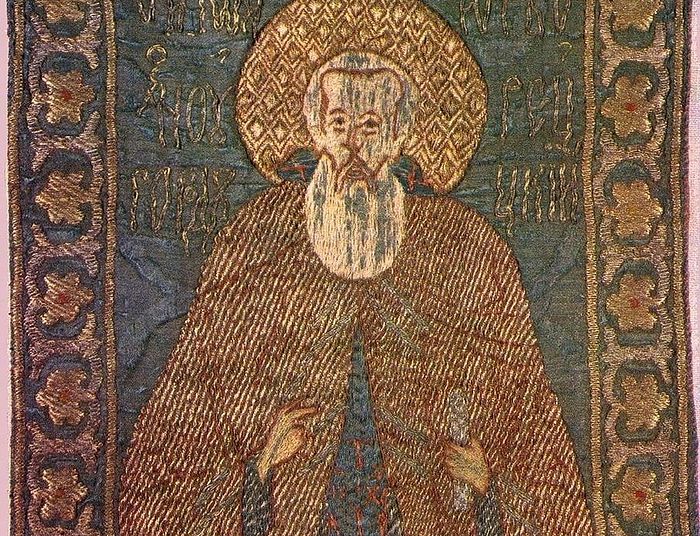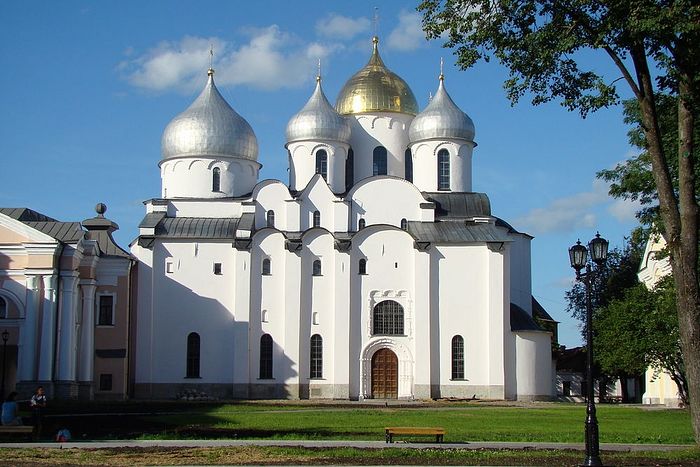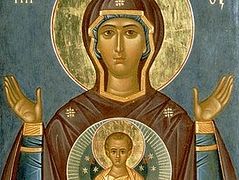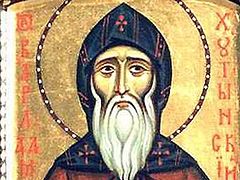A welcome klobuk, an unwelcome Panagia[1]
John was born in the city of Novgorod; his parents names were Christina and Nikolai. While still a boy, he decided to dedicate himself to God—at that time such piety was not considered something out of the ordinary. When John had grown, reaching adulthood, although in essence still a youth, he was ordained as a priest of the Church of the Hieromartyr Blaise, bishop of Sebaste (and this church, later rebuilt, has survived to our day).
When John’s parents died, he decided, having consulted with his brother Gabriel, to give all of his inheritance towards the building of a new monastery. The first task was to erect a wooden church: The brothers dedicated it to the Annunciation of the Most Holy Theotokos. The monastery grew, and soon it was decided to erect a durable stone church. The church was only half-built when construction froze, as often happens in our times when money runs out.
The brothers couldn’t find a “human” way out of the situation—only prayer remained. One night, in answer to the prayers of Gabriel and John, the Theotokos appeared to them to encourage them. “Only do not abandon this good work and do not grow cold in faith”—such was her message.
Indeed, the funds to continue building appeared almost literally from out of nowhere. The next day the brothers saw a horse standing by the gates of the monastery without a rider. They went closer to take a look and were stupefied: The horse had a rich harness inlaid with gold and two bags hanging on the side, tightly stuffed with gold and silver. They waited: Perhaps the rider would return, but they couldn’t wait that long. They removed the bags from the horse, took them to the monastery, and when they turned around, the horse had vanished.
The construction was completed, and the brothers gave the remaining money over to the discretion of the abbot of the monastery. Gabriel and John received the tonsure in the monastery that they themselves had built. Gabriel received the name Gregory, and John was named Elijah.
Time passed. One day, news of the passing of Archbishop Arkady of Novgorod reached the monastery. Arkady was the first bishop chosen by Novgorodians—at that time, from the end of the twelfth century, Novgorodians began to choose their own bishop, gathering “the whole city” in a local assembly, whereas previously he had been appointed by the bishop of Kiev.
In place of the newly-reposed Right Reverend Arkady, Novgorod unanimously chose John, whose moral qualities and faith were widely known; and, in spite of the poor ascetic’s resistance, desiring for himself neither honorable dignity, nor fame, he became the archpastor. Surrendering to the entreaties of the citizens, Elijah went to Kiev, where he was elevated to the rank of bishop and installed on the Novgorod cathedra. Two years later, the humble bishop was elevated to the rank of archbishop and became the first archbishop of a free Novgorod in history.
Brother against brother
The bloody feuds of Russian princes were in full swing in the twelfth century, and, of course, they couldn’t help but affect the richest trading city. In February 1170, a large united army of the Russian princes, led by the prince of Suzdal Mstislav Andreevich, the son of the renowned Andrew Bogolyubsky, moved towards Novgorod. A few years prior, Mstitslav had gone to Kiev in a similar campaign. The campaign ended with the capture and burning of the city: As the chronicle states, “And all the people in Kiev knew sorrow, mourning, and woe.”
Mstislav was at the walls of Novgorod. The princes and magistrates had already divided up the streets of the city between themselves, so obvious was their success. The residents were terrified; “grief and great sorrow seized them, and, bitterly lamenting, they prayed to the merciful God and His Most Pure Mother.” The siege lasted for three days—for three days without sleep the people prayed together with Archbishop John, and he had a revelation: to go to the church on Ilinskaya Street and take the icon of the Theotokos stored there out to the city walls.
The next morning, the icon was solemnly carried out of the church and raised on the walls. And suddenly, something happened that no one was expecting: The icon began to weep. St. John began to soak up the tears flowing from the Theotokos’ eyes with his stole… Thanks to such a clear miracle, the citizens of the city found their spirit again. The besiegers’ turn to be afraid and thrash about had come. According to the chronicle, darkness and fear fell upon them, chaos broke out in the camp, and people were rushing about, indiscriminately maiming and killing one another. At that moment, the Novgorodians went out beyond the city walls and threw themselves into the battle.
The siege of the city was lifted by evening, and the princes retreated from the city in disgrace. The next year, the archbishop went to negotiations in Vladimir with Prince Andrew Bogolyubusky, Mstislav’s father, to protect his flock and to facilitate the conclusion of peace for many years to come. The city began to live peacefully.
And, of course, they could not forget the miracle. From that time, Archbishop John established the feast of the Znamenny Most Holy Theotokos in Novgorod, which today is celebrated on November 27/December 10. A fourteenth century epic was written about this event—”A Word on the Znamenny Holy Theotokos,” and a century later the Athonite monk Pachomy Logofet wrote “A Word of Praise for the Znamenny” about it. They built the Monastery of the Theotokos on the Tithe on the spot where the weeping icon stood. The Znamenny Icon of the Mother of God itself was preserved in the church on Ilinskaya Street for 186 years, but in 1356 it was transferred to the church named in its honor (later becoming the Znamenny Cathedral). Today it has many famous copies; one of the icons adorned with the story of the Novgorodians’ victory over the Suzdalians can be seen in the Tretyakov Gallery.
To Jerusalem on a demon
The archbishop was, as they would say now, a talented missionary. He conducted conversations with laity, abbots, and priests on Confession, on Communion, on holiness. In one of these conversations the saint spoke about a man who had been tempted by a demon but subdued it, and traveled to Jerusalem on it in order to venerate the Tomb of the Lord. It is believed that the saint was speaking about himself, as ascetics usually did, so they wouldn’t be thought of as special.
The Novgorod archbishop was undoubtedly a man of holy life. The order of temptation of such ascetics is much higher than for regular people. As a saint of our days Paisios the Athonite describes, the temptations of laity are anger, incontinence, and even some crude sins, but evil spirits themselves may come to a monk who is finding success, in order to perturb and intimidate him.
Thus, this probably happened to Archbishop John. One night, as he was praying alone, he suddenly heard a noise and a splash of water, as if someone was splashing in the washbasin. Realizing that it was not a person, the saint arose, walked over to the washbasin and crossed himself. The disturber of his peace turned out to be a demon, relying upon a supernatural phenomenon to frighten and confuse the monk.
“Who are you and how did you get here?” the archbishop asked.
The demon said, “I am an evil demon, and I have come to bewilder you, thinking, that you, as a man, will be frightened and stop praying; but you have imprisoned me in this vessel and are torturing me. Release me, servant of God, and I will never come to you again!”
According to his life, the holy hierarch set a condition: He ordered the unclean one to take him to Jerusalem, to the Church of the Holy Sepulchre, and they arrived there the same night. The God-pleaser ordered the demon to stand still, and he went into the Church of the Resurrection of Christ. Approaching, he began to pray, and suddenly the closed doors of the church opened before him, and candles and lampadas were burning before the Tomb of the Lord. Having venerated the shrine and fulfilling his desire, he left the church; the demon was standing on the same place in the form of a saddled horse. Having sat on it, John returned to Novgorod the same night, and ended up in his cell. The demon begged the saint to leave his shame in secret, and from this request he turned to threats: “If you tell anyone how you traveled on me, then I will slander you so that everyone will condemn you as a fornicator!”
But the saint blessed himself with the Sign of the Cross, and the demon disappeared.
The holy hierarch told this story to others. With all his malice and guile, the demon did what he had threatened: He tried with all his might to slander the archbishop.
Many visitors would come to see the saint every day. The evil one would show them various visions: Someone would see a necklace in the archbishop’s cell, then women’s shoes would appear to him, or some article of women’s clothing. The people, of course, were confused. Rumors spread about the pastor: They really did start to suspect him of adultery.
One day, the people decided to find out the truth. The whole world went to the cell of their archpastor. The evil one turned into a girl and pretended to flee from the cell… It caused a terrible outrage. Hearing the screams and noise, the archbishop came out and asked what happened, and his “children” began to shout and condemn their archpastor, seized him, and began to mock the saint. And what to do next? This is what they decided to do:
“Let’s take him to the river and put him on a raft so he’ll float out of the city on the Volkhov River.
And so they did. The raft with the slandered monk floated off, but, as his life tells, not with the flow, but against it—up the river. The archbishop floated out of the city—both literally and figuratively.
“Forgive us, father!” was all the people could shout, catching up with the raft, weeping, and trying to bring back the saint they had driven out.
The righteous one forgave his spiritual children and returned to Novgorod. His words to those seeking for the truth and to those who were quick to condemn are just as fresh today as in the twelfth century:
“My children, do everything with circumspection, so as not to be tempted by the devil and so that your virtue will not be overshadowed by evil deeds.”
“The yoke of Christ is supposed to be light”
The holy hierarch soon reposed about a year after these events. He sensed his impending death and asked to be tonsured into the Great Schema. In this final tonsure, he was given the same name as in Baptism—John.
The saint managed to build seven churches throughout his ministry: of the Annunciation of the Most Holy Theotokos; the Theophany of the Lord; St. Elijah; St. Theodore the Studite; the Three Holy Youths Ananias, Azariah, and Misael and the holy Prophet Daniel; the holy Righteous Lazarus the four-days-dead; and St. Nicholas of Myra the Wonderworker.
About thirty written teachings remained from St. John. He instructed his priests in a simple and lively manner, speaking on the most elementary things:
“I beg you, do not get too attached to this world, but constantly teach the people. Above all, see that they do not indulge in strong drink. You yourselves know that more people die from it, and not just regular people, but us too. When your spiritual children come to you for Confession, question them with meekness. Do not place heavy penances on the repentant. Do not place any penances on orphans. Let all repent, for the yoke of Christ is supposed to be light.”
And he instructed monks:
“A monk must always be a monk, in all time and in all places—preserving the memory of death both asleep and awake, being fleshless in the flesh. Not for everyone does the monastery serve as healing for sensual pleasure, as does silence for anger, death for greed, and the tomb for avarice… The monastic life and worldly life are incompatible, as a camel and horse are not harnessed together… Being gods, take heed to not decay like people, and to not fall from the heights like Lucifer… From human glory is born pride.”
Upon the death of the holy hierarch his body was buried in St. Sophia Cathedral, and the people chose the saint’s blood brother Gregory for the Novgorod archespiscopal throne.
Over time the archbishop was forgotten, but in the fifteenth century his sepulchral plate was accidentally broken in St. Sophia’s, and under it were discovered his incorrupt relics. No one knew whose they were until it was revealed to Archbishop Ephraim in a dream.
St. John was glorified at the council of 1547. In 1919, the saint’s reliquary was opened by the staff of the Eighth Department of the National Commissariat of Justice, tasked with “the liquidation of the cult of dead bodies…” But as God did not desire to leave this man unknown in the fifteenth century, so in our times: Today St. John of Novgorod, longing for but one thing from his childhood—to be with Christ, is remembered and glorified in the Orthodox world.

